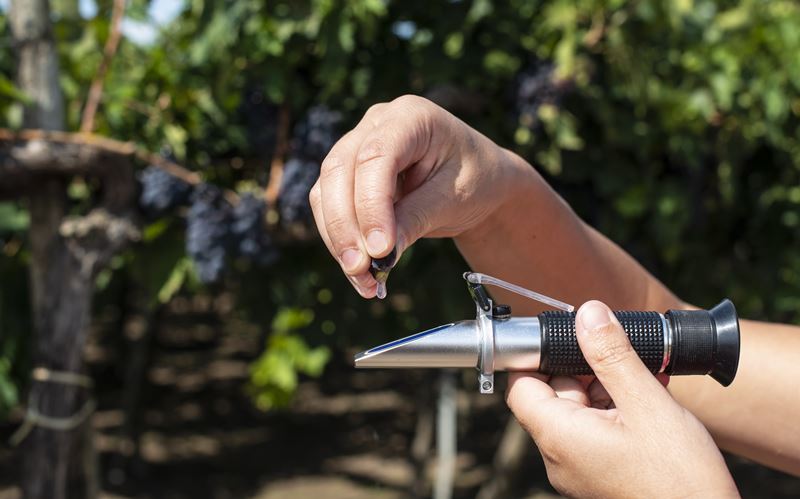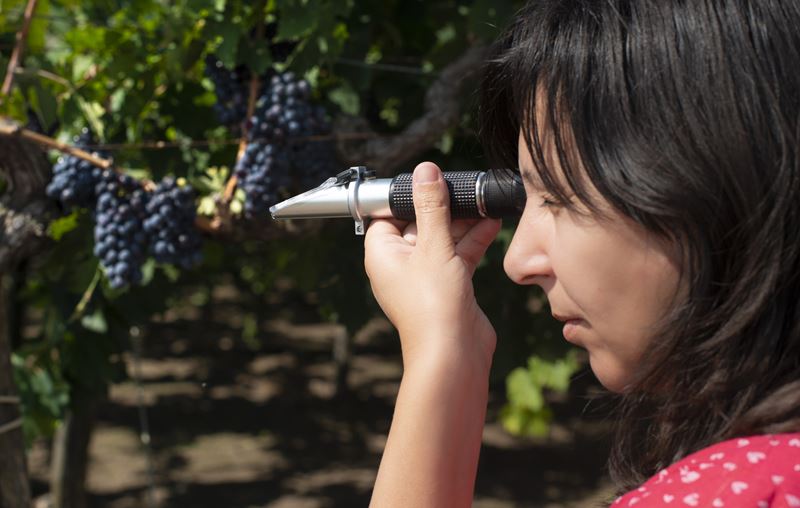
Ah, the refractometer! This tool might sound like something straight out of a sci-fi novel, but it's actually a winemaker's best friend and a crucial instrument in the art of winemaking. Let's uncork this topic and pour out the details on how a refractometer measures sugar and, indirectly, the potential alcohol content in wine, all without the need for a lab coat or a PhD in chemistry.
What's a Refractometer?
First things first: a refractometer is a handheld device that measures the concentration of an aqueous solution by evaluating how light bends, or refracts, as it passes through the liquid. When light enters a liquid from the air, it slows down and changes direction; the amount it slows by depends on the substance's density. Sugar increases the density of grape juice, so by shining a light through a sample, a refractometer can tell us how much sugar is in there. It's like a magic wand for winemakers, providing a quick and easy way to check the ripeness of their grapes.

Measuring Sugar Content
To measure the sugar content, a small sample of grape juice is placed on the refractometer's glass surface. The device is then pointed towards a light source, and the winemaker looks through the eyepiece. Inside, the refractometer has a special scale, typically measured in Brix in winemaking, which directly correlates to the percentage of sugar in the juice. The winemaker reads where the line of light intersects with the scale, and voila, the sugar content is revealed. This process is crucial during the harvest period, as it helps determine the optimal time to pick the grapes to achieve the desired balance of sweetness, acidity, and potential alcohol in the wine.
From Sugar to Alcohol Potential
Now, you might be wondering, "How does this translate to alcohol content?" Well, the science of winemaking has provided formulas that convert sugar levels into potential alcohol content. Since yeast ferments sugar into alcohol during the winemaking process, knowing the initial sugar content gives winemakers a pretty good estimate of how alcoholic the wine can become. This estimation is vital for winemakers aiming for a specific style or alcohol level in their wines. By adjusting fermentation conditions, they can influence the final outcome, making the refractometer an indispensable tool in their toolkit.
The Catch: Post-Fermentation Measurements
Here's where things get a bit sticky. Once fermentation begins, alcohol's presence complicates using a refractometer for direct measurements because alcohol affects the refraction of light differently than sugar does. This means that while refractometers are fantastic for measuring sugar content before fermentation, they're not as straightforward to use for measuring alcohol content directly. However, with some mathematical adjustments and additional tools like hydrometers or specialized alcohol refractometers, winemakers can still get a good idea of the alcohol content.
Why It Matters
Using a refractometer allows winemakers to make informed decisions throughout the winemaking process, from optimal harvest times to managing the fermentation process for desired wine characteristics. For wine enthusiasts, understanding the role of a refractometer offers a glimpse into the precision and care that goes into producing each bottle of wine. It's a blend of tradition and technology, where ancient art meets modern science, ensuring every sip is as delightful as intended.
So, the next time you're swirling a glass of wine, remember the refractometer and the crucial role it played in bringing that wine to your table. Cheers to the tools and techniques that transform simple grapes into the complex and enjoyable wines we love!
| More information |
|---|
| What are Brix, Baumé or Oechsle? |
Founded in 2007, Vinetur® is a registered trademark of VGSC S.L. with a long history in the wine industry.
VGSC, S.L. with VAT number B70255591 is a spanish company legally registered in the Commercial Register of the city of Santiago de Compostela, with registration number: Bulletin 181, Reference 356049 in Volume 13, Page 107, Section 6, Sheet 45028, Entry 2.
Email: [email protected]
Headquarters and offices located in Vilagarcia de Arousa, Spain.